You and I both know I’m not too familiar with the concept, but we’ll make the attempt, okay?
Anyway, I have a buttload of photos that I’d like to feature before I even get to the beach trip, but not enough time to do detailed posts about them, so I’ll toss down some brief descriptions and possibly send the rest over to the Latest Images page. Sound like a plan?
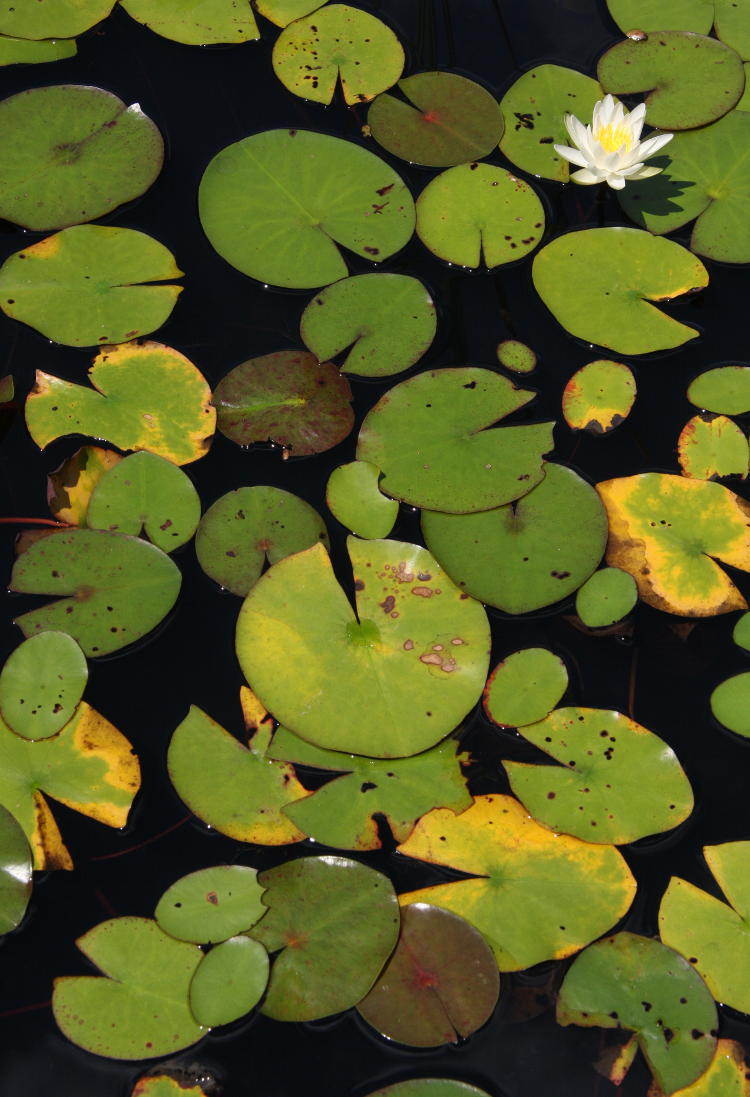
I took this to illustrate that, even if the focus is the lily, we can always do more with the framing. We won’t miss it even all the way up there in the corner, but now it’s an accent to the patterns of the pads.
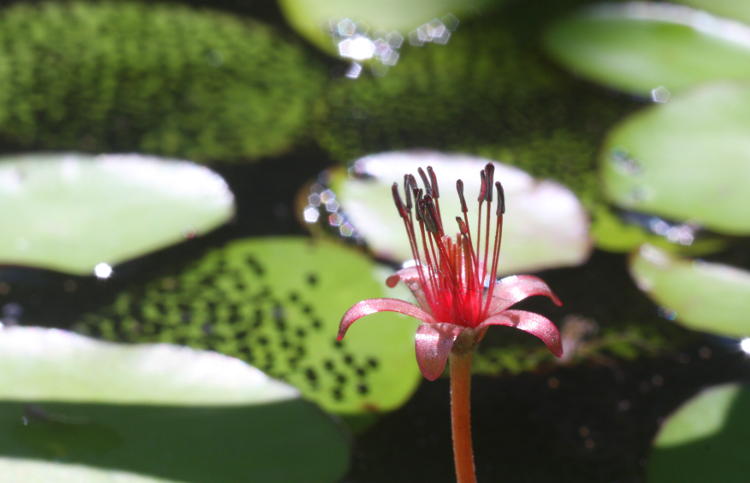
Another illustration of framing and selective focus; the background dots are a large quantity of amphibian eggs on the water’s surface.
Demonstrating the difference that positioning and effort can make. This is what the Chinese mantis (Tenodera sinensis) looked like when first spotted. Pretty humdrum.
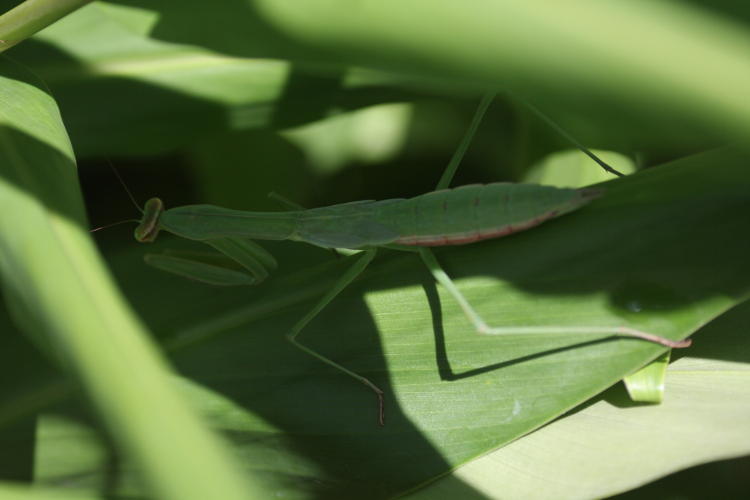
But then, I carefully shifted around, endeavoring not to disturb the plant at all, to change the viewing angle, finding a small gap in the leaves to work with.

Now we have a more personal angle, and the furtiveness and ‘hidden’ aspect gets enhanced, even though they’re really the same location. Certainly better than a dorsal view. These, by the way, date from late July – I’m further behind than I thought.
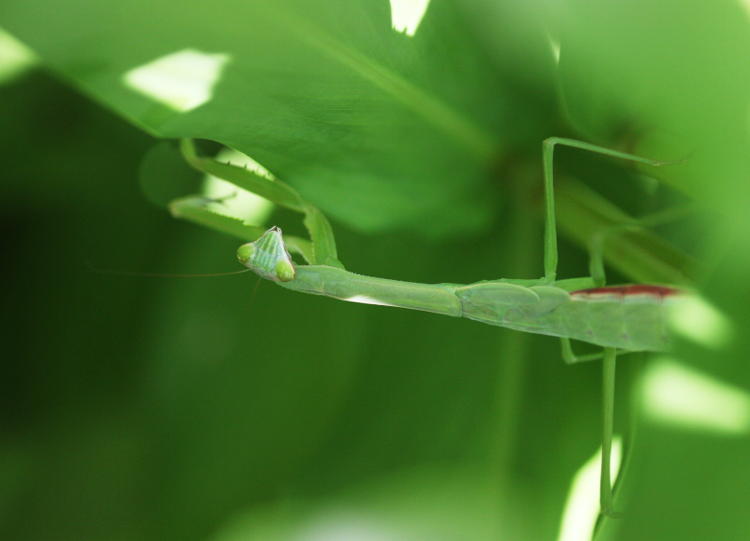
A little later on in the same session, the mantis had moved to a spot that was easier to access, and when it turned to watch what I was up to, that’s when I took the shot. Just a simple demonstration of the small differences that are easy to accomplish.
Let’s get a little variety of color in here.

I watched this locust/grasshopper fly from the lawn onto a flower blossom, and stalked it carefully to keep from spooking it again, knowing that it would still be wary after the initial scare. This was a frame that I’d considered using for the latest macro photography post, about doing more than illustration, but I passed it over in favor of better examples, so it appears here now. Makes you wonder who was stalking who, right? At least that was my intention.
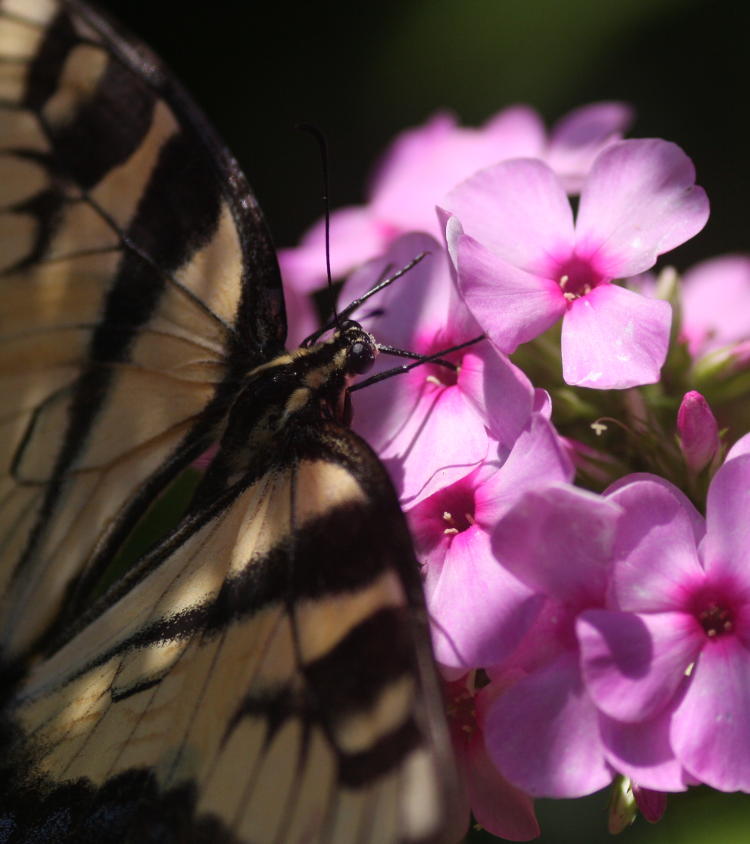
This one is merely illustration, though illustration of habits and details rather than just basic anatomy, at least, captured as a tiger swallowtail (Papilio glaucus) delved deep into a phlox blossom. As I’ve often observed, there’s a lot of luck involved, but recognizing that the focus had to be on a specific point and that I had a bare couple of seconds to achieve this played prominently, as well. The ability to exploit the lucky circumstances, is what I’m saying – I gotta take some credit.
 Okay, back to green.
Okay, back to green.
I knew that the Carolina anoles (Anolis carolinensis) favored the banana and nearby palmetto plants in the botanical garden where all of these (so far) were taken, so we spent some time looking them over carefully to try and find some – that’s how the previous mantids were found, as well. Eventually, we were successful in finding a half-size juvenile, obviously this year’s brood, who was wary of our presence.
Following it carefully, we watched to see if it was going to provide a useful pose. It is worth nothing that the banana plant that it was perambulating across had huge leaves and was off the immediate path, so getting close or choosing a large variety of angles wasn’t going to happen – which is fairly typical for just about any kind of nature photography. This might look like I’m right on top of it, but it’s a tight crop from the Mamiya 80mm macro, and I was better than a meter away from it. Doesn’t sound like a lot, but the anole was only about 7cm in length to begin with, tail included – a ‘normal’ view would have had it almost disappearing against the huge leaves and stems and their assorted shadows. And ‘shadows’ is a key word here, because eventually, it jumped across to the right spot, and I was able to change position adequately.
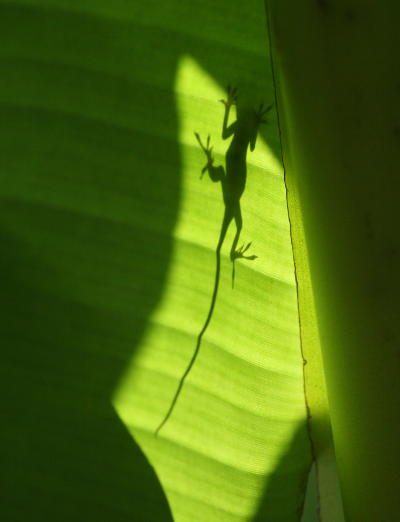 Alas, my timing was just a bit off, and the anole had crept forward enough to put its head in shadow before I could get set to capture the silhouette that I was after. So this isn’t really the print-quality fartsy shot I had tried to achieve, but at least serves to illustrate thinking of a more creative approach.
Alas, my timing was just a bit off, and the anole had crept forward enough to put its head in shadow before I could get set to capture the silhouette that I was after. So this isn’t really the print-quality fartsy shot I had tried to achieve, but at least serves to illustrate thinking of a more creative approach.
The toes, of course, are the same size in each photo, but show up a lot more impressively in this one because of the contrast. There’s also the curious idea, which just now hit me, that the anole is holding a leaf up to its face with the forelegs, perhaps a member of the Witness Protection Program, or maybe just tipping some ants down to its mouth. I probably spend too long looking at my own photos…
But here’s another little observation: the textures of the backlit leaf are an element all their own, and I’ve shot such before just as abstracts. Now, though, I have a brand new goal of trying to get an anole silhouette in such a way that the leaf textures and the anole’s shape and position coincide, the curves matching and accentuating one another. I’m not expecting to nail this one anytime soon, but it’s the very awareness of these factors that will make me watch carefully for them to occur. Granted, this vigil will likely begin next spring at least, as we’re nearing the end of anole season here.
We found another of the same size that day, who is going to transition this post from green to brown – the frame below isn’t exciting, but the pose is adequate and the details are nice.
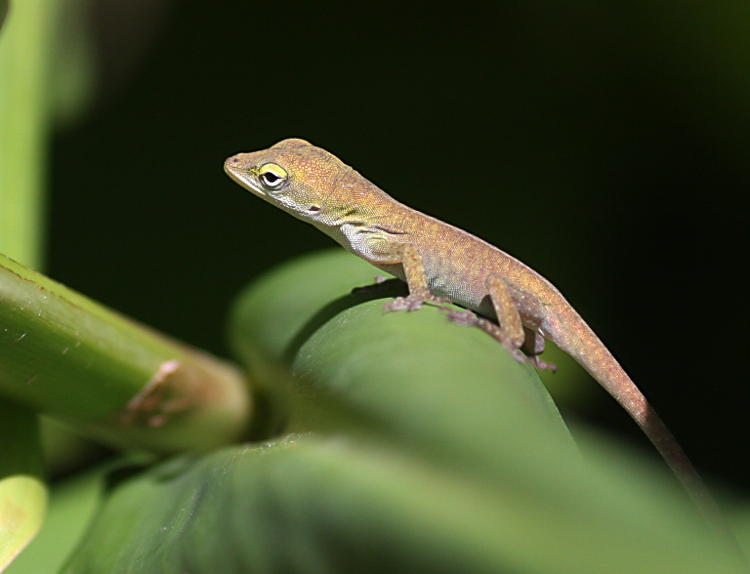
The coloration is not indicative of a different sex, just a mood display, though I couldn’t tell you what provoked this – the behavior was perhaps a little less wary than the previous, but obviously it’s not trying to blend in here, and perhaps had spotted another anole (that we missed) that it was warning off. I’ve seen such changes occur, by the way, and it’s pretty fast – a second or two if they’re motivated.
Now we move on to a different day and location.
When my brother visited, he demonstrated that his spotting skills were competitively slick as he found this mantis that I had just passed.
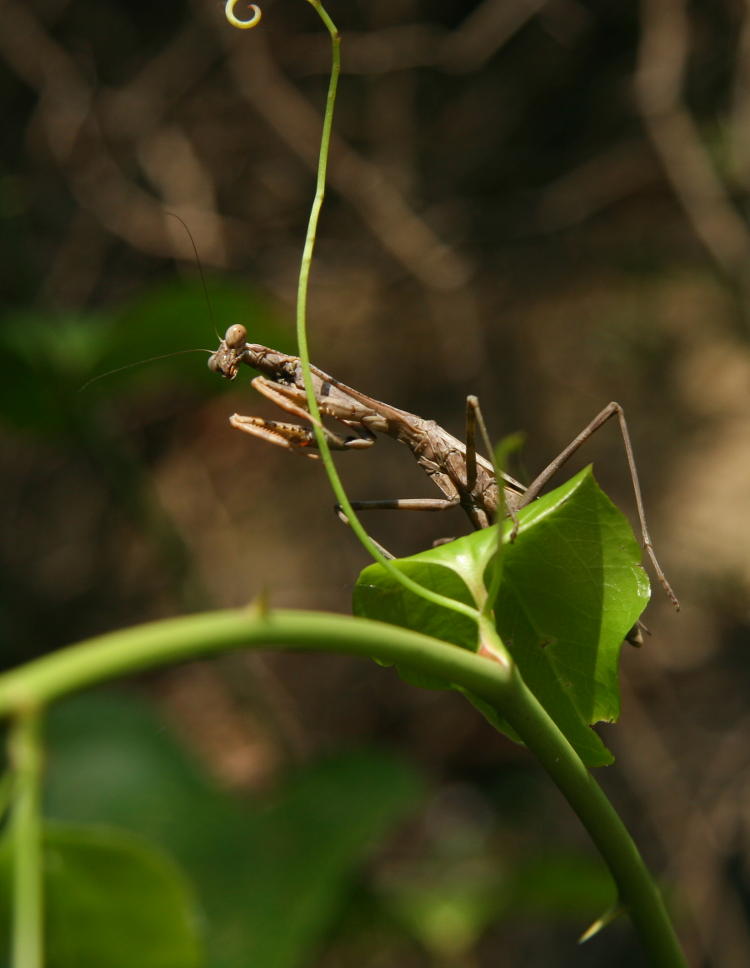
This is a Carolina mantis (Stagmomantis carolina,) about half the size of the more-common Chinese mantis that has appeared more often on this blog than any other species by far. I got slightly more of a scale shot when we let it stalk down his arm, but I should have backed off more to get the thickness of his arm in there, at least – I was concentrating on the mantis details and not thinking about what use I might put it to.
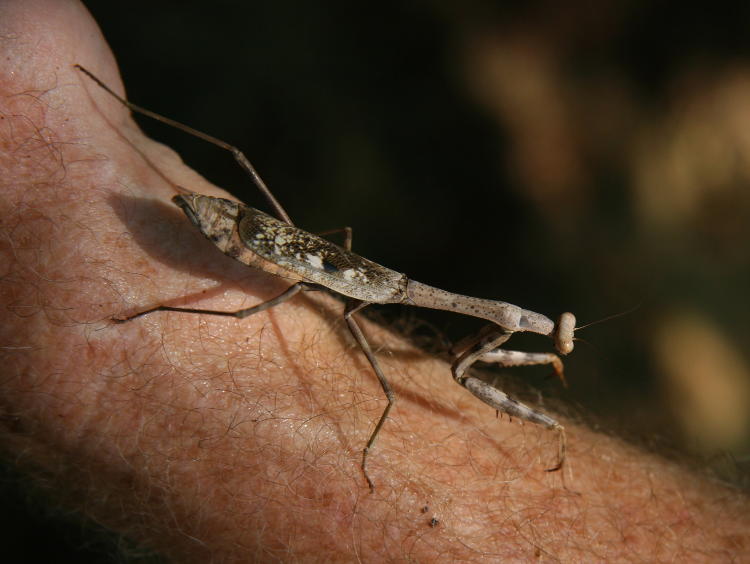
The swollen abdomen outclassing the wings pegs this as likely a pregnant female. The coloration is more widely variable than the Chinese, but the ‘urban camouflage’ pattern here is fairly common.
And I’ll close with a dragonfly from the same brief outing, one that I crept up to after a mating pair proved too elusive for any decent shots.
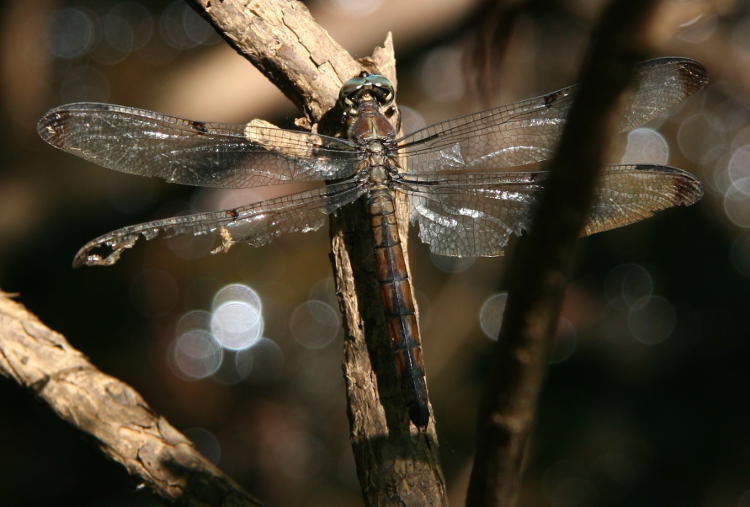
This is likely (as near as I can determine, anyway,) a great blue skimmer (Libellula vibrans,) judging from the eye and abdomen coloration and the dark tips to the wings; this took way too long to research. The tattered wings showed no visible detriment to its flying ability, and if I remember right, experiments done on several four-winged species indicated that the secondary wings were more for added maneuverability than much else, almost being redundant. Which seems odd to me, because the resources to develop and maintain such wings, which are clearly used in flight, could be better spent somewhere else; numerous other insect species have near-vestigial hindwings. But as I’ve said before, I just shoots ’em…



















































